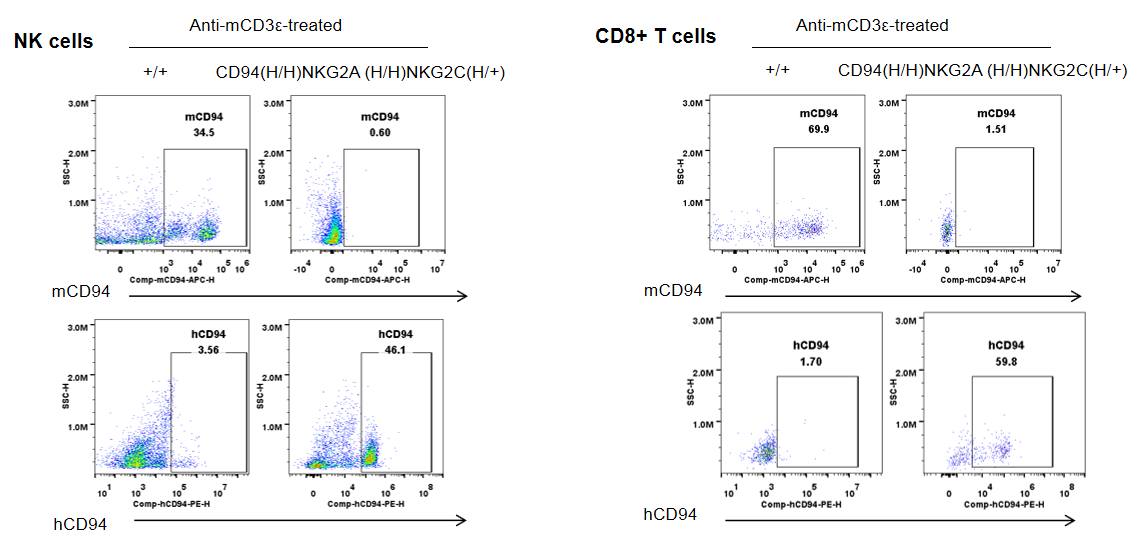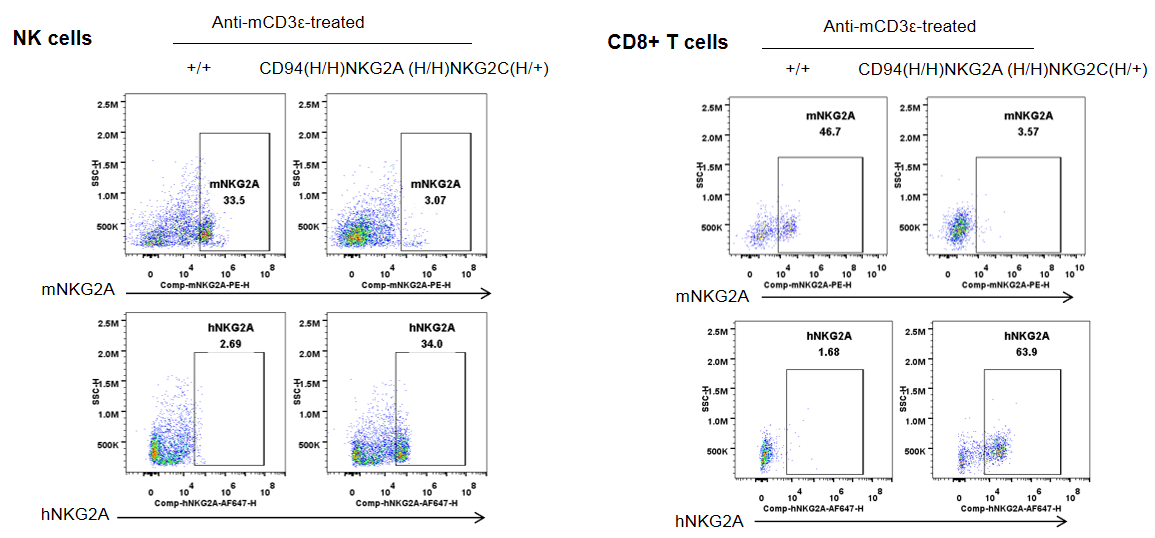


C57BL/6-Klrd1tm1(KLRD1)BcgenKlrc1tm1(KLRC1)BcgenKlrc2tm1(KLRC2)Bcgen/Bcgen • 112445
| Product name | B-hCD94/hNKG2A/hNKG2C mice |
|---|---|
| Catalog number | 112445 |
| Strain name | C57BL/6-Klrd1tm1(KLRD1)BcgenKlrc1tm1(KLRC1)BcgenKlrc2tm1(KLRC2)Bcgen/Bcgen |
| Strain background | C57BL/6 |
| Aliases | KLRD1(CD94); KLRC1(NKG2A,CD159A); KLRC2(NKG2C,CD159C) |
Gene targeting strategy for B-hCD94/hNKG2A/hNKG2C mice.
The exons 3-6 of mouse Cd94 gene that encode the extracellular domain were replaced by human CD94 exons 3-6 in B-hCD94/hNKG2A/hNKG2C mice;
The exons 2-6 of mouse Nkg2a gene that encode the extracellular domain were replaced by human NKG2A exons 2-6 in B-hCD94/hNKG2A/hNKG2C mice;
The exons 2-5 of mouse Nkg2c gene that encodes the extracelluar domain was replaced by human NKG2C exons 2-6 in B-hCD94/hNKG2A/hNKG2C mice.

Strain specific CD94 expression analysis in heterozygous B-hCD94/hNKG2A/hNKG2C mice by flow cytometry. Splenocytes were collected from wild-type mice and heterozygous B-hCD94/hNKG2A/hNKG2C mice and stimulated with anti-CD3ε in vivo (7.5 μg/mice, stimulation for 24 hours, i.p. ), and analyzed by flow cytometry with species-specific anti-CD94 antibodies. Human CD94 were exclusively detectable in heterozygous B-hCD94/hNKG2A/hNKG2C but not in wild-type mice.

Strain specific NKG2A expression analysis in heterozygous B-hCD94/hNKG2A/hNKG2C mice by flow cytometry. Splenocytes were collected from wild-type mice and heterozygous B-hCD94/hNKG2A/hNKG2C mice and stimulated with anti-CD3ε in vivo (7.5 μg/mice, stimulation for 24 hours, i.p. ), and analyzed by flow cytometry with species-specific anti-NKG2A antibody. Human NKG2A were exclusively detectable in heterozygous B-hCD94/hNKG2A/hNKG2C but not in wild-type mice.

Strain specific NKG2C expression analysis in heterozygous B-hCD94/hNKG2A/hNKG2C mice by flow cytometry. Splenocytes were collected from wild-type mice and heterozygous B-hCD94/hNKG2A/hNKG2C mice and stimulated with anti-CD3ε in vivo (7.5 μg/mice, stimulation for 24 hours, i.p. ), and analyzed by flow cytometry with species-specific anti-NKG2C antibody. Human NKG2C were exclusively detectable in heterozygous B-hCD94/hNKG2A/hNKG2C mice but not in wild-type mice.